For too long, product teams have measured success by what they ship, not the results they drive. A roadmap packed with features looks productive, but it often leads to building products that miss the mark on customer value and business impact. This focus on output creates a gap between being busy and being effective.
The OKRs for Product Management framework closes this gap by shifting the focus from outputs to outcomes. It provides a clear system for setting ambitious goals and tracking the specific results that prove real value creation. This article walks through how to write effective product OKRs, integrate them with agile development, and build outcome-driven roadmaps.
Take a few moments to read this blog and discover how to avoid common mistakes and use OKRs to align engineering, business, and leadership teams around shared goals.
Key takeaways
- Focus on user outcomes, not features: write OKRs that measure real impact on users rather than just shipping features. This shift transforms vague goals into concrete results that drive business value.
- Use the three to five objective rule: limit yourself to three to five objectives per quarter with two to four key results each. More objectives dilute focus and reduce your chances of meaningful progress.
- Aim for 70% success to drive innovation: set stretch goals where achieving 70% represents significant progress. This encourages creative problem-solving and inspires teams to take calculated risks.
- Break down silos with shared objectives: create cross-functional OKRs that unite product, engineering, and marketing around common goals. This builds alignment and eliminates the guesswork about priorities.
- Centralize OKRs in one flexible platform: manage objectives, key results, and daily work in a single workspace that adapts to your team’s workflow. Solutions like monday dev help connect strategy to execution without forcing rigid processes.
What are OKRs in product management?
OKRs (Objectives and Key Results) are a goal-setting framework that helps product teams connect strategy to measurable outcomes. This means you set ambitious goals (objectives) and track specific metrics (key results) to prove you’re achieving them.
Objectives represent your strategic destination, while key results serve as measurable indicators of progress toward that goal. For product teams, this framework transforms vague aspirations such as “improve the product” into concrete, measurable goals like “increase user engagement by 40%.”
Understanding objectives vs key results
Objectives answer “what do we want to achieve?” They’re qualitative statements that inspire your team. Key results answer “how will we know we got there?” They’re quantitative metrics that prove success.
To use OKRs correctly, it’s crucial to understand the distinct roles of objectives and key results. Objectives provide the inspirational ‘what,’ while key results offer the measurable ‘how,’ ensuring your goals are both ambitious and grounded in data.
- Objectives inspire action: they paint a picture of success that motivates teams, like “Create the most intuitive onboarding experience in our industry”.
- Key results measure progress: they use numbers to track achievement, like “Reduce onboarding drop-off from 30% to 10%”.
- Objectives stay flexible: they give teams room to find creative solutions.
- Key results stay specific: they leave no room for interpretation about success.
When should the product teams use OKRs?
OKRs work best when you need clarity, alignment, and measurable progress. They’re especially powerful when your product team faces complexity or change.
Consider using OKRs in these situations:
- Launching new products: define success beyond just shipping features.
- Scaling your team: keep everyone aligned as you grow.
- Changing direction: focus efforts during strategic pivots.
- Breaking down silos: create shared goals across departments.
- Improving focus: replace scattered priorities with clear targets.
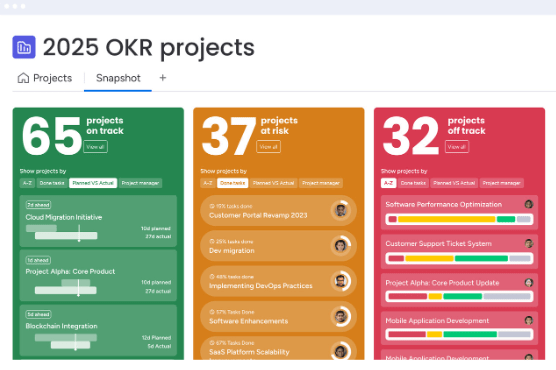
Why product teams need OKRs in 2026
Product teams today juggle more complexity than ever. You’re managing distributed teams, evolving customer needs, and constant market changes. OKRs give you a framework to navigate this chaos while staying focused on what matters.
How do you ensure everyone rows in the same direction when your team spans time zones and departments? OKRs create that alignment by making goals visible and measurable for everyone. According to a 2022 McKinsey survey, 70% of organizations that adopted OKRs reported improved strategic alignment across teams, with 60% noting faster decision-making cycles.
Strategic alignment across departments
OKRs solve the age-old problem of departments working in isolation. When engineering, product, marketing, and sales share an objective like ‘Accelerate mobile app adoption,’ each team contributes their expertise toward a common goal. For example, a study from the Journal of Organizational Design found that teams using shared goal-setting frameworks reported a 25% increase in cross-functional project success.
monday dev makes this alignment visible by connecting team workflows to shared objectives. You can see how engineering’s stability improvements support marketing’s user acquisition campaigns. This transparency eliminates the guesswork about priorities and dependencies.
Shifting from output to outcome metrics
Most product teams track outputs: features shipped, bugs fixed, stories completed. But shipping features doesn’t guarantee value. OKRs shift your focus to outcomes; the actual impact on users and business. For example, research from the Product Development and Management Association (PDMA) indicates that outcome-focused teams are 45% more likely to meet their quarterly targets.
Consider these examples of output versus outcome thinking:
- Output: launch chat feature by Q2.
- Outcome: increase user engagement by 25% through real-time communication.
- Output: fix 50 bugs this sprint.
- Outcome: improve app stability rating from 3.5 to 4.5 stars.
- Output: complete user research project.
- Outcome: reduce feature adoption time from 14 to 7 days.
Building team ownership and autonomy
OKRs empower teams by clarifying the “what” while leaving the “how” open. Your team owns the objective “Reduce customer churn by 20%” but decides whether to improve onboarding, enhance features, or strengthen support.
This autonomy drives engagement. Teams feel trusted to find solutions rather than just executing prescribed tasks. Platforms like monday dev support this flexibility by letting teams design workflows that match their approach, whether that’s Scrum, Kanban, or something unique.
OKRs vs KPIs and traditional product strategy
Product teams often confuse OKRs with KPIs or treat them as interchangeable metrics. While both frameworks measure performance, they serve fundamentally different purposes in your product strategy.
Understanding these differences will really help you use each tool effectively: OKRs to drive breakthrough progress and KPIs to maintain operational health. This section clarifies how OKRs complement rather than replace traditional metrics, and how they connect to your broader product vision.
How product OKRs differ from KPIs
OKRs push teams to achieve ambitious goals. KPIs monitor ongoing health. Both matter, but they measure different things.
OKRs ask “what breakthrough can we achieve this quarter?” KPIs ask “are we maintaining our standards?” You need both perspectives for a complete picture of product performance.
- OKRs change quarterly: you set new objectives based on current priorities.
- KPIs stay consistent: you track the same metrics month after month.
- OKRs encourage stretch: achieving 70% is considered success.
- KPIs require consistency: you must hit targets reliably.
- OKRs drive transformation: they focus on step-changes in performance.
- KPIs ensure stability: they monitor business-as-usual metrics.
Connecting OKRs to product vision
Your product vision describes the future you’re creating. Strategy outlines your path. OKRs break that path into concrete milestones.
Imagine your vision is “Make project management effortless for small businesses.” Your strategy might focus on simplicity and automation. This quarter’s OKR could be “Reduce setup time for new users” with key results tracking specific improvements.
Quarterly goals within long-term strategy
Quarterly OKRs keep you moving toward long-term goals while staying responsive to change. Each quarter builds on the last, but you can adjust course based on what you learn.
If your annual goal is “Expand into enterprise market,” your quarterly OKRs might progress from “Validate enterprise needs” to “Launch enterprise pilot” to “Scale enterprise adoption.” This progression maintains strategic focus while allowing tactical flexibility.
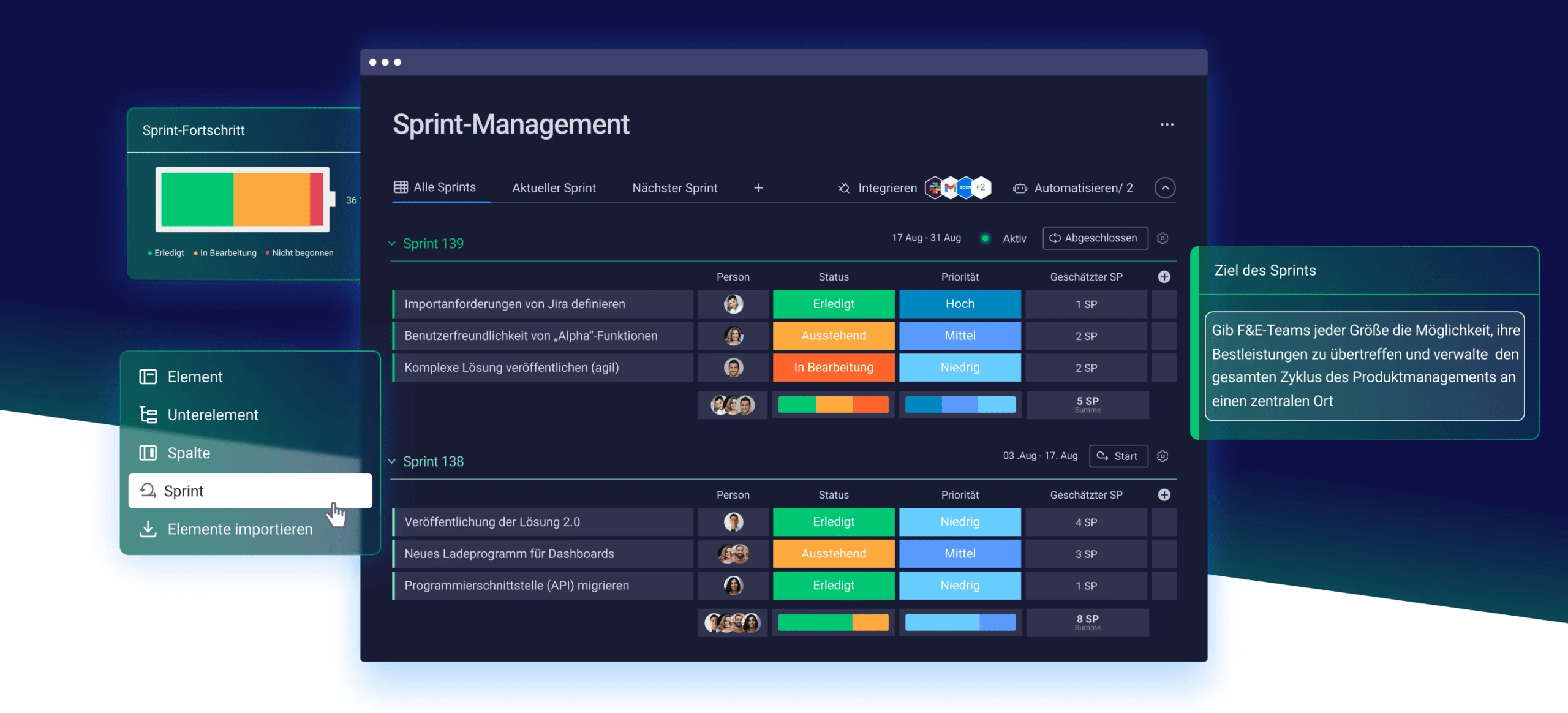
5 steps to write effective product OKRs
Writing effective product OKRs requires a structured approach that balances ambition with measurability. The following five steps guide you through creating OKRs that drive real impact, from identifying user outcomes to validating your goals with stakeholders. Each step builds on the last, ensuring your OKRs align with both user needs and business objectives.
Step 1: start with user outcomes
Great product OKRs start with user needs, not internal metrics. Ask yourself: what change do we want to see in how users experience our product?
User-focused objectives might include:
- Reduce time to first value for new users: help users experience product benefits faster.
- Increase power user productivity: enable advanced users to accomplish more in less time.
- Improve accessibility for users with disabilities: ensure all users can navigate and use your product effectively.
Avoid internal-focused objectives like “refactor codebase” unless they directly impact users. Every objective should connect to user value.
Step 2: Define measurable key results
Key results prove you’ve achieved your objective. They must be specific, measurable, and time-bound. Each key result should clearly support the objective.
Test your key results with these questions:
- Can you measure it with a number: quantifiable metrics eliminate ambiguity about success.
- Does it describe an outcome, not an activity: focus on results rather than tasks completed.
- Is it ambitious but achievable: stretch your team without setting impossible targets.
- Does achieving it prove progress toward the objective: ensure each key result directly supports your goal.
Step 3: Set stretch goals that inspire
OKRs should push your team beyond business as usual. Aim for goals where 70% achievement represents significant progress. This encourages innovation and prevents sandbagging.
What would success look like if your team performed at their absolute best? That’s your stretch goal. Platforms like monday dev help track progress toward these ambitious targets, letting you adjust tactics without losing sight of the goal.
Step 4: Align with business objectives
Product OKRs must support company goals. If the business aims to “expand internationally,” your product objective might be “enable multi-language support” with key results measuring adoption in new markets.
This alignment ensures your product work drives business results. Regular check-ins with leadership keep your OKRs connected to evolving company priorities.
Step 5: Validate with cross-functional teams
OKRs affect multiple teams. Validate your draft OKRs with engineering, design, marketing, and sales to identify dependencies and ensure feasibility.
Ask these validation questions:
- Does everyone understand and support the objective: shared understanding prevents misalignment down the road.
- Are the key results truly measurable: confirm you have access to the data needed for tracking.
- What support does each team need to succeed: identify resource requirements and dependencies early.
- Are we being ambitious enough: push for stretch goals that inspire breakthrough thinking.
Product OKR examples that drive results
The best way to understand OKRs is to see them in action. These real-world examples show how product teams translate strategic goals into measurable outcomes across different focus areas. Each example demonstrates the balance between ambitious objectives and concrete key results that prove progress.
Use these templates as starting points, then customize them to fit your product’s unique context and challenges.
Customer engagement OKRs
Engagement OKRs focus on how users interact with your product. They measure active usage, satisfaction, and feature adoption. These objectives help you understand whether users find ongoing value in your product, not just whether they signed up initially.
Objective: increase mobile app engagement.
- Key result: grow daily active users from 10,000 to 13,000.
- Key result: improve session duration from five to eight minutes.
- Key result: achieve 70% adoption of push notifications.
Objective: delight users with seamless onboarding.
- Key result: reduce time to first value from 15 to 5 minutes.
- Key result: increase onboarding completion from 60% to 85%.
- Key result: achieve 4.5+ satisfaction score for onboarding experience.
Product launch OKRs
Launch OKRs define success beyond simply shipping a feature or product. They focus on market adoption, user satisfaction, and business impact from day one. These objectives help teams avoid the trap of celebrating a launch without measuring whether anyone actually uses what you built. Launch OKRs keep teams accountable for driving real adoption, not just hitting release dates.
Objective: successfully launch analytics dashboard.
- Key result: acquire 100 paying customers within 30 days.
- Key result: achieve 4.0+ average rating in user feedback.
- Key result: drive 30% adoption among existing enterprise clients.
Performance and reliability OKRs
Performance OKRs address the technical foundation that enables great user experiences. Speed, stability, and reliability might not be flashy, but they directly impact user satisfaction and retention. These objectives matter especially when technical debt has accumulated or when you’re scaling to serve more users. Performance improvements often deliver immediate, measurable impact on user behavior and business metrics.
Objective: deliver lightning-fast user experience.
- Key result: reduce average page load time from 2.5s to 1.2s.
- Key result: maintain 99.95% uptime throughout the quarter.
- Key result: decrease customer-reported performance issues by 60%.
Market expansion OKRs
Expansion OKRs guide your entry into new market segments or geographies. They balance customer acquisition with product readiness and sustainable growth. These objectives help teams avoid the mistake of chasing new markets before your product truly fits their needs. Market expansion OKRs ensure you’re building the right capabilities while simultaneously proving demand in your target segment.
Objective: win the SMB market segment.
- Key result: onboard 500 new SMB customers.
- Key result: achieve 80% feature parity with SMB competitor offerings.
- Key result: maintain 5% monthly churn rate for SMB segment.
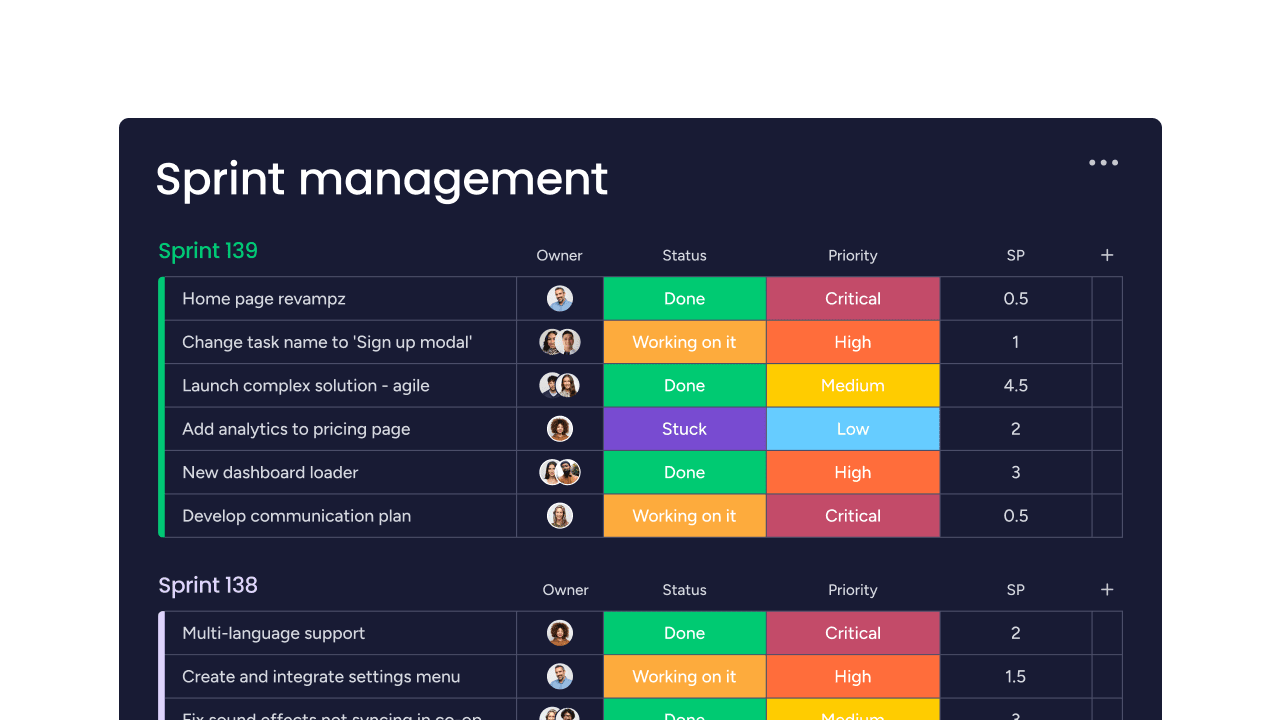
Integrating OKRs with Agile product development
Agile and OKRs complement each other perfectly when implemented correctly. While Agile provides the framework for iterative development and continuous delivery, OKRs ensure that work stays focused on measurable outcomes. The challenge lies in connecting sprint-level execution to quarterly objectives without losing the flexibility that makes Agile effective.
- Use OKRs to guide sprint planning: during sprint planning sessions, prioritize work based on which tasks directly advance your current OKRs. If your objective is “Reduce customer churn,” focus on retention-impacting features over nice-to-have additions. Sprint tasks link directly to OKRs in monday dev, showing how daily work advances quarterly goals and helping teams make informed trade-offs.
- Map epics directly to objectives: connect your product epics to specific OKR objectives, ensuring each Agile epic advances at least one key result. Work that doesn’t support current OKRs gets deprioritized or deferred to future quarters. This connection prevents scope creep by giving you a simple filter for feature requests — ask stakeholders “Which OKR does this support?” and defer anything that doesn’t align with current goals.
- Stay agile while maintaining fixed goals: OKRs set the destination, not the route, allowing teams to adjust tactics based on learnings while keeping objectives stable. If your planned approach isn’t delivering results, pivot to a new solution that still supports the objective. Weekly check-ins help teams spot when tactics need adjustment before it’s too late to course-correct.
How to align product roadmaps with OKRs
Your product roadmap is more than a timeline of features — it’s a powerful tool that connects daily execution to quarterly objectives. When aligned with OKRs, roadmaps transform from static delivery schedules into dynamic outcome maps that demonstrate business value.
Moving from feature lists to outcome maps
Feature roadmaps tell stakeholders what you’ll build. Outcome roadmaps explain why it matters and how you’ll measure success.
Instead of “Launch chat feature in Q2,” your roadmap shows “Increase user collaboration by 40% in Q2.” This approach helps stakeholders understand the business impact of product work.
Quarterly planning that works
Effective quarterly planning balances strategic direction with team input. Start by reviewing company objectives, then collaborate with teams to set product OKRs that support those goals.
Include these participants in planning:
- Product managers: provide market insights and competitive intelligence.
- Engineering leads: assess technical feasibility and resource requirements.
- Design: contribute user experience perspective and usability considerations.
- Sales and marketing: share customer feedback and market demands.
Communicating progress to stakeholders
Different audiences need different levels of detail. Executives want high-level progress toward business impact. Teams need specific metrics and blockers.
Dashboards provided by platforms like monday dev create audience-specific views of OKR progress. Share live dashboards instead of static reports, ensuring everyone sees current data without manual updates.

"monday dev empowered us to optimize our GTM approach, resulting in faster, more dependable deliveries"
Steven Hamrell | Director of Product Management
"monday dev empowers us to manage the entire development process on one platform so we can speed up product delivery and improve customer satisfaction"
Mitchel Hudson | Head of Technology
"We're operating in an open, deep trusting, transparent environment with no silos of information. It's about completely opening access to everyone who needs it."
Alan Schmoll | Executive Vice President, Vistra PlatformModern OKR tracking and measurement
Setting OKRs is just the beginning: tracking progress effectively determines whether your objectives translate into real results. Modern OKR management relies on real-time visibility, regular team alignment, and consistent scoring methods that encourage honest assessment. The right tracking approach keeps teams focused on outcomes while providing the flexibility to adjust tactics when needed.
Here’s how to build a measurement system that drives accountability without creating reporting overhead.
Real-time progress dashboards
Effective dashboards show objective status, key result trends, and risk indicators at a glance. They update automatically, eliminating manual reporting.
Advanced solutions like monday dev pull data from multiple sources into unified dashboards. You see how work across teams contributes to shared objectives without switching between platforms.
Weekly team check-ins that work
Keep check-ins brief and focused on problem-solving. Review key result progress, identify blockers, and assign actions for the coming week.
Structure your check-ins around three questions:
- What progress did we make this week: celebrate wins and quantify movement toward key results.
- What’s blocking our progress: identify obstacles early so teams can address them quickly.
- What help do we need: surface resource gaps and dependencies that require leadership support.
Scoring methods for product teams
Most teams use a 0-1 scale where 0.7 represents good progress. Some prefer percentages or color coding. Choose a method that encourages honest assessment.
Use scoring to spark conversations, not judge performance. A key result at 0.5 prompts discussion about obstacles and solutions, not blame.
AI and automation in OKR management
Manual OKR tracking consumes valuable time that product teams should spend building and improving products. AI and automation transform OKR management from a reporting burden into a strategic advantage by collecting data automatically, surfacing insights proactively, and predicting potential roadblocks before they derail progress. This shift lets teams focus on achieving objectives rather than updating spreadsheets, while providing more accurate, real-time visibility into what’s actually working.
Predictive analytics for goal achievement
AI analyzes patterns to predict OKR success likelihood. Early warnings about at-risk objectives let teams intervene before falling behind.
If progress toward a key result slows, predictive analytics can flag this trend and suggest corrective actions based on what worked in similar situations.
Automated progress collection
Connect your analytics, CRM, and project management platforms to track key results automatically. Metrics update in real-time without manual data entry.
Modern platforms like monday dev integrate with your existing platforms, pulling data into OKR dashboards automatically. This ensures accuracy while saving hours of manual reporting.
Smart insights from historical data
Past OKR performance reveals patterns that improve future planning. Teams learn which goals tend to be too ambitious or too easy, calibrating more accurately over time.
Review historical data to answer questions like:
- Do we consistently over or underachieve: identify patterns in goal-setting accuracy to calibrate future objectives.
- Which types of objectives drive the most impact: focus on goal categories that consistently deliver business value.
- What tactics repeatedly deliver results: replicate successful approaches across similar objectives.
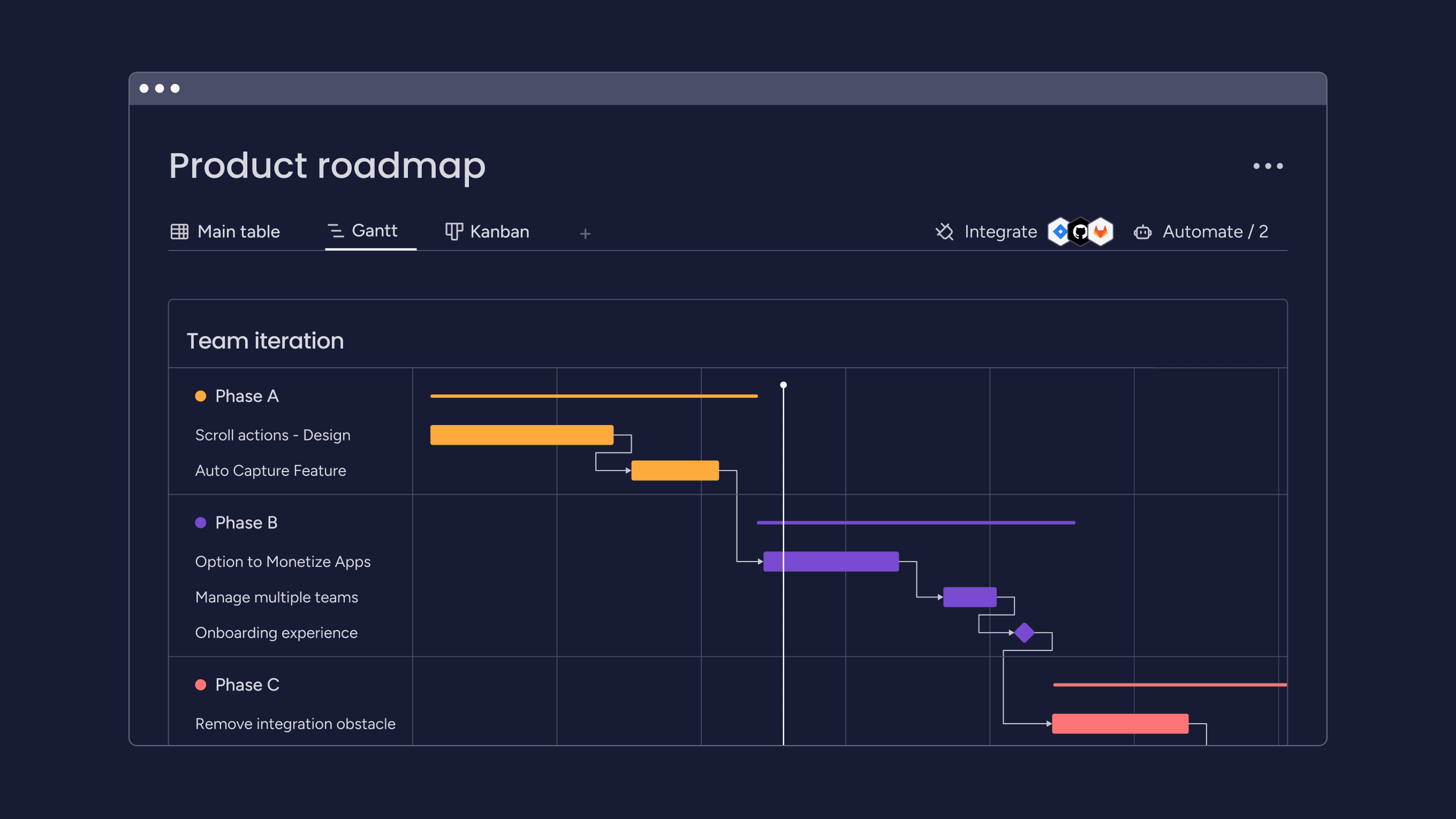
7 best practices for successful product OKRs
Even well-intentioned product teams fall into common traps when implementing OKRs. These pitfalls can transform a powerful goal-setting framework into just another bureaucratic exercise that drains time without driving results. The difference between OKRs that energize your team and those that become shelf-ware often comes down to a few critical practices. This section highlights the most common mistakes and shows you how to avoid them, ensuring your OKRs remain focused, ambitious, and genuinely useful for driving product success.
- Creating too many objectives: more than three to five objectives dilutes focus. Prioritize what matters most.
- Writing task lists instead of key results: “conduct user interviews” is a task. “Increase NPS by 15 points” is a key result.
- Setting unambitious goals: if you always achieve 100%, you’re not pushing hard enough. Aim for 70% success.
- Ignoring cross-team dependencies: product OKRs often need engineering, design, and marketing support. Identify dependencies early.
- Skipping regular reviews: weekly or bi-weekly check-ins keep OKRs relevant and actionable.
- Using vanity metrics: choose key results tied to real business value, not impressive-sounding numbers.
- Forcing top-down OKRs: teams need input in setting their objectives to feel ownership and commitment.
How to engineer cross-functional OKR success
Product success rarely happens in isolation. The most impactful outcomes emerge when product, engineering, design, marketing, and sales work toward shared goals rather than competing priorities. Cross-functional OKRs break down the departmental silos that slow progress and create misalignment, replacing them with transparent collaboration around common objectives. This section shows you how to structure shared goals that unite teams, create visibility without micromanagement, and build the trust needed for truly collaborative product development.
Breaking down department silos
Shared objectives unite different departments around common goals. When product, engineering, and marketing share “Accelerate enterprise adoption,” each contributes their unique expertise.
Advanced solutions like monday dev provide visibility across departments, showing how each team’s work supports shared objectives. This transparency builds trust and improves coordination.
Creating shared product objectives
Structure shared objectives so multiple teams contribute while maintaining individual accountability. Each team owns specific key results that support the shared objective.
For example:
- Shared Objective: delight users with instant support.
- Product Key Result: launch in-app help center with 80% self-service rate.
- Support Key Result: resolve 95% of tickets within two hours.
- Engineering Key Result: maintain 99.9% uptime for support systems.
Enabling visibility without micromanaging
Transparency builds trust, but teams need autonomy to achieve results their way. Provide visibility into progress without dictating methods.
Leaders should ask “how can I help?” not “why did you do it that way?” Dashboards can give stakeholders the visibility they need while preserving team autonomy; platforms like monday dev offer this balance through customizable views that inform without micromanaging.
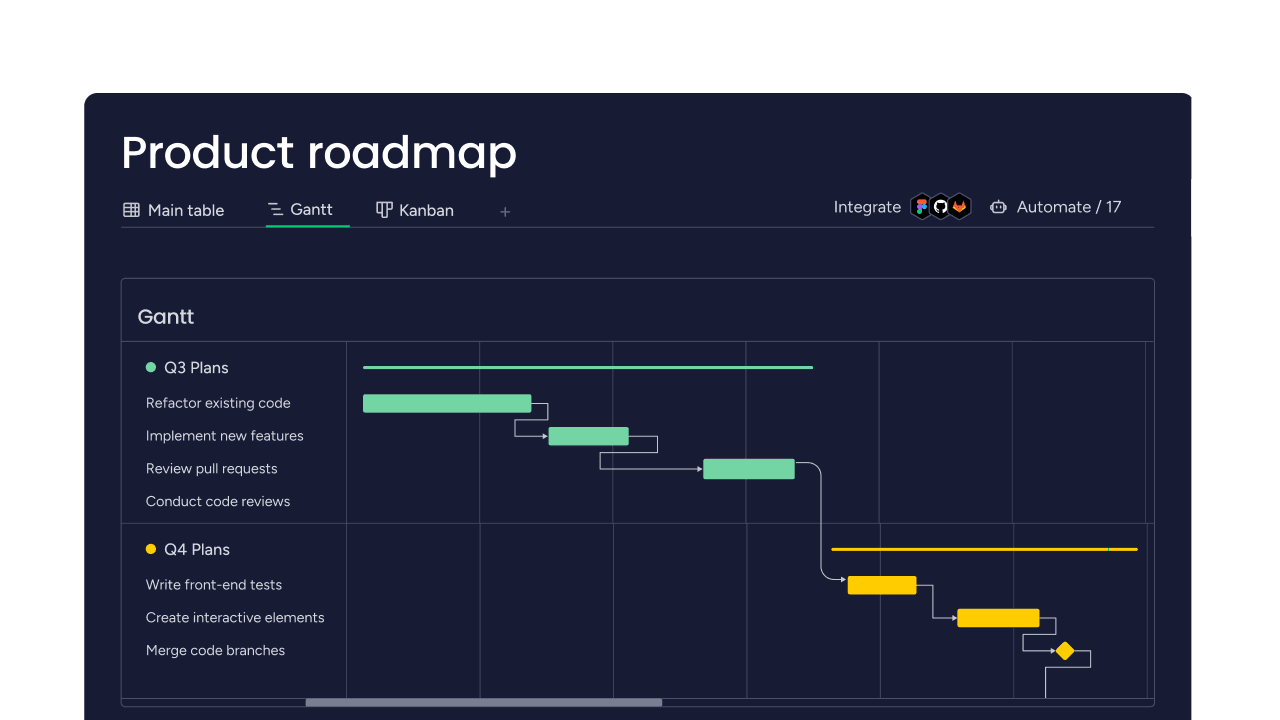
Transform your product OKRs with monday dev
Structure meets flexibility in monday dev’s approach to OKR management, giving modern product teams the adaptability they need. Built on the monday.com Work OS, it adapts to how you work rather than forcing rigid processes.
Flexible OKR workflows for any team structure
Every team works differently. Customize OKR tracking to match your team’s unique needs with monday dev, whether you’re a startup or enterprise.
Create custom boards for OKR tracking, sprint planning, and roadmap management. Use the platform’s drag-and-drop interface to design workflows that reflect your team’s process. Connect boards to show how daily work advances quarterly goals through dependencies and automations. Leverage pre-built templates for common OKR structures, or build your own from scratch.
Real-time visibility across product development
Stakeholders at every level need different views of OKR progress. Customizable dashboards from monday dev update in real-time, pulling data directly from your boards.
Build executive dashboards that display high-level progress toward strategic objectives using chart widgets, progress bars, and status summaries. Create team-focused views that drill into specific key results, blockers, and supporting work items.
Further, use the platform’s filtering and grouping capabilities to segment data by team, priority, or timeline. Everyone gets the information they need without creating reporting overhead — dashboards refresh automatically as teams update their work.
Seamless integration with your tech stack
Your OKR data lives across multiple platforms — analytics, CRM, project management. Connect these platforms with monday dev through 200+ native integrations and a robust API, automating data collection for key results.
Pull engagement metrics from Google Analytics, conversion data from Salesforce, and development progress from GitHub or Jira into unified dashboards. Set up automations that update key result values when specific conditions are met: like incrementing a counter when deals close or bugs are resolved. Use Zapier or Make integrations to connect virtually any tool in your stack.
Collaborative features that drive alignment
OKR success depends on team collaboration and clear communication. Built-in features from monday dev keep everyone aligned without endless meetings.
Use @mentions to notify team members about OKR updates or blockers. Add context with file attachments, links, and rich text updates directly on OKR items. Set up automated notifications when key results reach certain thresholds or fall behind schedule. Conduct asynchronous check-ins using the updates section, where teams can share progress, ask questions, and provide feedback.
Sprint planning connected to objectives
Bridge the gap between strategic OKRs and tactical sprint work with monday dev’s sprint planning capabilities. Create sprint boards that link directly to your OKR objectives, showing how each user story or task contributes to quarterly goals.
Use the platform’s workload view to balance capacity across team members while prioritizing OKR-aligned work. Track story points, time estimates, and actual effort to improve future planning accuracy. Run retrospectives using dedicated boards that capture learnings and action items.
The platform’s flexibility supports Scrum, Kanban, or hybrid approaches—whatever helps your team deliver on OKRs most effectively.
Frequently asked questions
How do OKRs work for remote product teams?
OKRs work exceptionally well for remote product teams by providing clear alignment and shared priorities across locations. The framework creates a common language for discussing progress, reducing the miscommunication that often challenges distributed teams. Digital platforms like monday dev make it easy to track and share OKR progress without constant meetings.
Can small product teams benefit from OKRs?
Small product teams benefit from OKRs when they need focus and clarity around priorities. The framework helps even two-person teams align on what matters most and track progress objectively. Start with one or two objectives and simple tracking methods, adding complexity only as your team grows.
What's the ideal number of product OKRs per quarter?
The ideal number is three to five objectives per quarter, each with two to four key results. This range balances comprehensive coverage with maintained focus. More objectives dilute attention and reduce the likelihood of achieving meaningful progress on any single goal.
How do I transition from feature roadmaps to OKRs?
Transitioning from feature roadmaps to OKRs starts with identifying the outcomes each feature should deliver. Ask "why are we building this?" for each planned feature, then reframe your roadmap around those outcomes. Map existing features to objectives and use key results to measure their impact.
Should product manager OKRs cascade from company objectives?
Product manager OKRs should align with company objectives to ensure everyone moves in the same direction. This doesn't mean copying company OKRs verbatim — instead, translate high-level business goals into product-specific objectives that your team can directly influence.
How do product team OKRs support innovation?
Product team OKRs support innovation by setting ambitious outcomes while leaving solution discovery open. Teams experiment with different approaches to achieve key results, learning what works through rapid iteration. The 70% success target encourages risk-taking and creative problem-solving.
